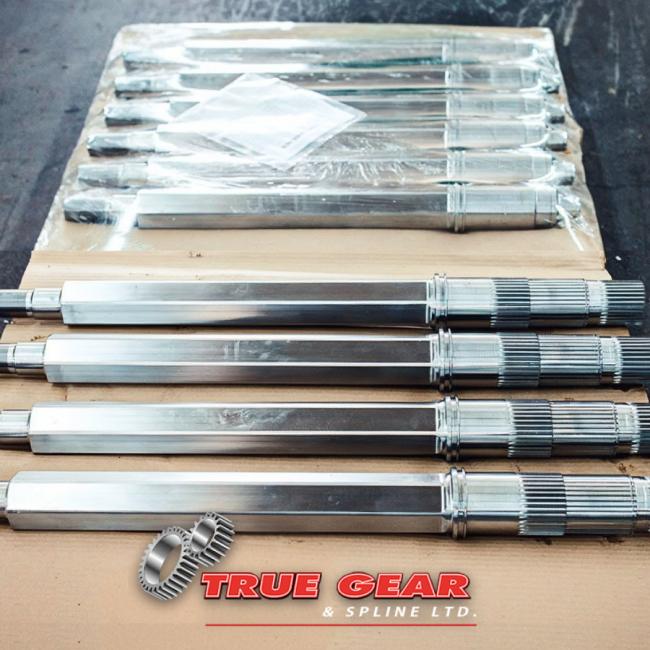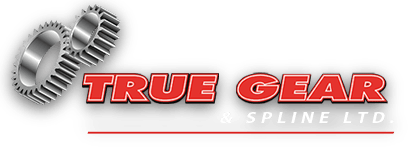Keep up to date with us on the latest industry news as well as what's going on at True Gear & Spline Ltd. We also post articles for insider tips and tricks, so make sure to check back frequently.
Involute vs. Straight Splines: Which Splined Shaft Do You Need?

If you take a list of things industries cannot thrive without, torque transmission would be right at the top. Gears, splined shafts, and couplings are the important elements that facilitate seamless torque transmission.
We have taken the time to discuss the importance and applications of gear couplings in depth. True Gear & Spline Ltd. is the industry leader when it comes to manufacturing spur and bevel gears as well.
In this blog, we focus merely on splined shafts. Did you know that involute and straight are the two most popular splined shafts in the market?
Read this blog until the end to learn the key differences between the two. By the end of this blog, you will know which blog works best for your particular requirements.
What Are Straight Splines?
Definition and Design Features
Straight splines are characterized by straight ridges that mate perfectly with matching grooves in hubs or gears. The ridges are cut lengthwise and at equal distances from each other. They resemble parallel keys in design and are highly effective in transferring torque, distributing load, and ensuring alignment.
Common Applications of Straight Splines
- Automotive steering systems
- Agricultural equipment
- Industrial machinery couplings
- Gear couplings
- Machine tool spindles and holders
- Pumps and compressors
- Construction equipment
- Marine equipment
- General engineering applications
Advantages of Straight Splines
Ease of Manufacturing
The simple, no-fuss design of straight splines makes them easy to manufacture. An experienced gear manufacturer will have the resources to manufacture even large batches with a short turnaround time.
Cost-Effective
The ease of manufacturing and simple design translate to a lower upfront cost. Straight splines made of top-quality metals and alloys are very durable, making them a cost-effective torque transmission solution.
High Torque Capacity
The size-to-torque ratio of straight splines is among the best. Even a seemingly small spline shaft can provide impressive torque output. This can be attributed to the larger surface area when compared to gears. The lengthwise ridges facilitate better torque transmission.
Easy Assembly/Disassembly
The simple and compact design makes assembly and disassembly relatively simpler. The non-complex geometry facilitates quick, seamless mating. You don’t have to spend a lot of time or money on the installation. Even better, your downtime is kept to a minimum.
Limitations of Straight Splines
Uneven Load Distribution
One of the biggest problems with straight splines is the concentration of stress at the edges. This contributes to accelerated wear and tear, gradually causing reduced efficiency. This uneven load distribution could be because of manufacturing or assembly errors. Even imperfect tooth-to-tooth loading contributes to increased localized stress.
Not Suitable For Precision-Demanding Applications
Tight tolerances and high strength are prerequisites for certain industrial applications. It is best not to rely solely on straight splines in such scenarios.
No Self-Centring Ability
Straight splines rely on manual centring through tight minor or major diameter fits. Clearances are undesirable as they cause the spline shaft to wobble, shake, and vibrate, contributing to debilitating instability.
Low Misalignment Tolerance
Even the slightest misalignment can be detrimental for straight splines. Higher stress accumulation on edges due to angular or parallel misalignments causes accelerated wear. If not kept in check, misalignment causes frequent replacement of straight splines.
What Are Involute Splines?
As the name suggests, they feature curved teeth shaped in an involute profile. It is similar to that of an involute gear but shorter. Gradual contact, as opposed to simultaneous contact of straight splines, and improved load sharing are distinct features of involute splines that make them efficient and reliable.
Applications of Involute Splines
- Automotive transmissions and drivetrains
- Heavy-duty gearboxes
- Aerospace components
- Power generation equipment
- High-torque industrial drives
- Railway traction systems
- Wind turbine gear systems
- Precision robotics and automation equipment
- High-performance pumps and compressors
- Military and defence vehicles
Advantages of Involute Splines
Uniform Load Distribution
Thanks to the involute profile, the load is evenly distributed across all teeth. This results in higher load capacity. For high-torque applications that demand precision, involute splines are perfect.
Minimal Vibration
The smoother, more gradual contact of involute splines minimizes vibration and noise. Unchecked vibration is detrimental to high-precision applications and results in premature wear and tear.
Self-Centering
Alignment is crucial for seamless torque transmission. The problem with straight splines is that they lack self-centring ability and must be manually loaded. Involute splines, on the other hand, are naturally self-center when loaded. This helps maintain exceptional alignment even in high-torque applications.
Limitations of Involute Splines
Complex Manufacturing
The relatively complex design of involute splines makes manufacturing relatively more difficult. The need for complex machining, cutting, and grinding means a slightly longer turnaround time. They demand rigorous quality testing and inspection to prevent manufacturing flaws.
Not Ideal For Simple Applications
Sometimes, manufacturers rely on involute splines even when not needed. This poses a risk of overengineering, creating unnecessary problems and complexities. Involute splines are not suitable for low-load applications, adding unnecessary costs.
Inappropriate for Axial Motions
Involute splines are not ideal where axial sliding or frequent linear movement between the mating parts is required. Their curved tooth engagement provides excellent torque transfer but limits smooth axial motion.
Checklist for Comparison:
✔ Identify torque requirements
✔ Define tolerance needs
✔ Evaluate load conditions
✔ Consider long-term maintenance
✔ Balance cost vs. performance
How to Select the Right Splined Shaft for Your Application
Step-by-Step Selection Process
1. Define Functional Requirements
2. Identify Torque and Power Transmission Needs
3. Consider Axial vs. Radial Load Conditions
4. Choose Spline Geometry
5. Match to Industry Standards
6. Assess Manufacturing Feasibility
7. Validate Design with Tools & Testing
8. Consult with Suppliers/Manufacturers
9. Compare Costs vs. Long-Term Benefits
Checklist for Quick Review
✔ Torque capacity confirmed
✔ Correct spline geometry chosen (involute/straight)
✔ Standards matched with mating components
✔ Manufacturing feasibility ensured
✔ Design validated with simulations/tests
✔ Supplier consultation completed
Why Custom Splined Shafts May Be the Best Option
Standard or off-the-shelf splines lack the efficiency needed for specialized applications. You can ensure precise tolerance with the help of custom splined shafts.
From diameter and volume to heat treatment and geometry, many factors can be controlled in custom splined shafts.
You can work with an experienced manufacturer like True Gear & Spline Ltd. to ensure flawless customization, durability, and cost effectiveness.
Trust True Gear & Spline Ltd For Custom Splined Shafts
Look no further than True Gear & Spline Ltd. for reliable splined shafts in Toronto, GTA, and Ontario. With over 50 years of experience, we are the true pioneers of Ontario’s gear and splined shaft manufacturing scene.
Our 22,000-square-foot manufacturing facility is equipped with cutting-edge tools, machinery, and equipment, enabling us to produce the highest-quality torque transmission solutions.
The combination of state-of-the-art technology and experienced employees means we manufacture top-quality torque transmission solutions consistently.
Apart from gear and spline shaft manufacturing, we also offer gear hobbing, CNC machining, bevel-gear cutting, gear couplings, and grinding at the best rates. Talk to our team today to learn about all we can do for you.
FAQs
What is the difference between a spline and a gear?
A spline is a series of ridges on a shaft that fit into grooves in a mating component, transmitting torque without slippage. A gear transmits power between two rotating shafts by meshing with another gear.
Are involute splines stronger than straight splines?
Yes. Involute splines provide smoother load distribution, higher torque capacity, and greater durability compared to straight splines.
What are the advantages of splined shafts?
Splined shafts ensure accurate torque transfer, maintain shaft-hub alignment, allow for axial movement, and reduce slippage compared to keyed shafts.
How are splined shafts manufactured?
They can be manufactured using processes such as broaching, hobbing, shaping, milling, and grinding, depending on geometry and tolerance requirements.
Can splined shafts be custom-made?
Absolutely. Manufacturers offer custom splined shafts to meet unique torque, geometry, or material requirements, ensuring precise fit and performance.








